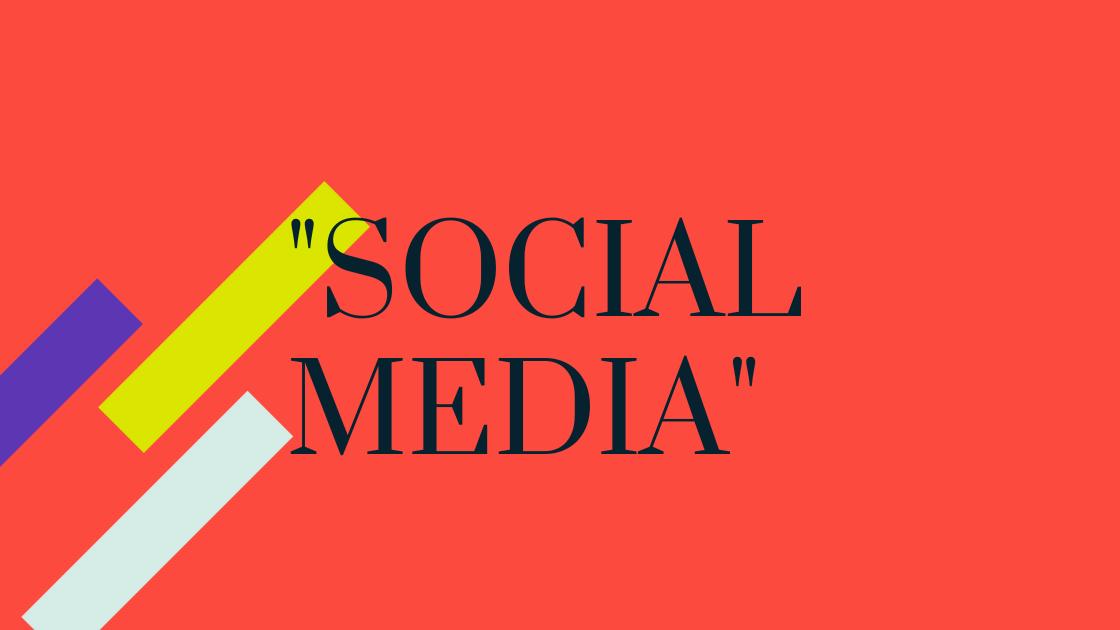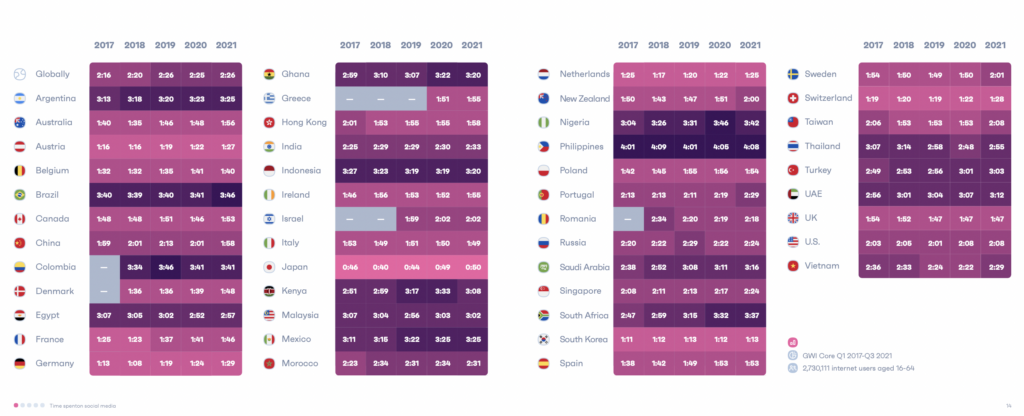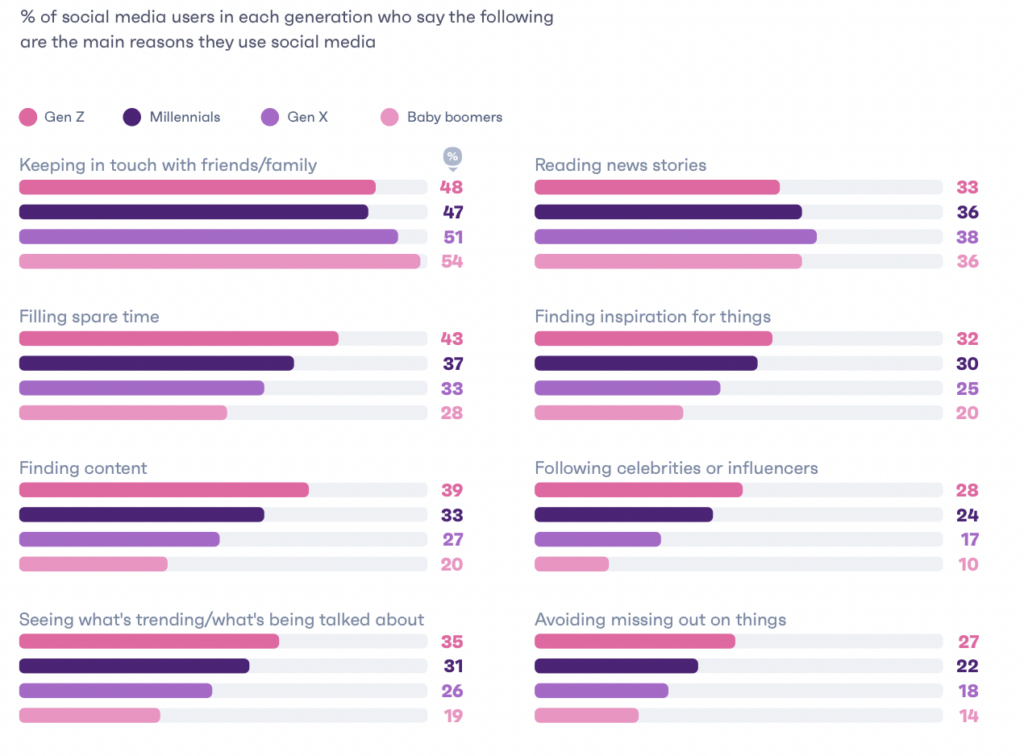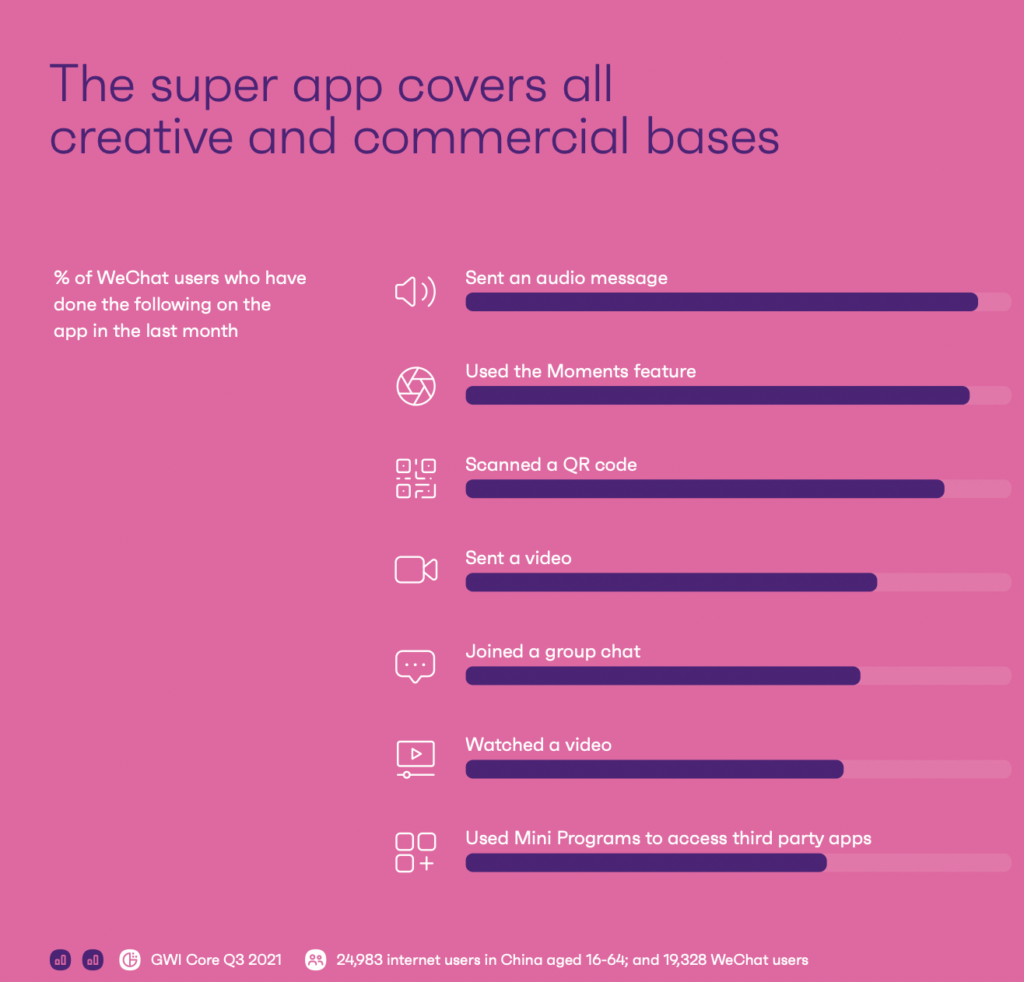In many cases, the „latest holiday statistics” (at the end of the year) are not too surprising, especially if you read during the year about social media, content consumption habits, generational characteristics, time spent in front of screens – and similar – topics.
We have managed to cherry-picked quite a few data which, if not „unbelievable”, are nevertheless thought-provoking (in our opinion, thought-provoking is much better than unbelievable). Research data on social media use were published by GWI. Have fun browsing through them!
The richer the society is, the less its members hang out on social media?
Even if the formula is not that simple, it is certainly telling that which countries’ residents spend the most and the least time, in general, on social media channels.
Based on the data of the 48 countries examined separately, the Japanese spend by far the least amount of time in front of the screen: only 50 minutes a day on average. In Europe, Switzerland (average 1 hour 28 minutes per day) and the Netherlands (average 1 hour 25 minutes per day) are spending the least time, but Japan is directly followed by another Asian country, namely South Korea (average 1 hour 13 minutes per day). At the other end of the scale is the Philippines, where Internet users spend an average of 4 hours and 8 minutes a day on a social media platform. The Philippines is followed by Nigeria and Colombia (3 hours 42 and 3 hours 41 minutes, respectively).
Let everyone draw their own conclusions based on the social characteristics, structure, well-being, and economy of the given country.
This is what we say why we use social media
The highest proportion of users indicate maintaining contact as the reason for visiting social media (48%-54%), the second most common reason is „filling free time” (28%-43%). The first reason was indicated by the baby boomer generation in the largest proportion, and the second reason was indicated by them in the smallest proportion. The older someone is, the less they use the platforms to follow and „check” celebrities and influencers. There is also an inverse logic between FoMO and age: it is most characteristic of generation Z that FoMO drives them to the platforms, and least of all for the 58+ age group.
It seems that the more time someone spends on social media platforms and the more platforms they are present on, the easier it is to develop the illusion that they can miss out on anything if they are not present. It will be interesting to see in 5 years how these data develop as time progresses: it will always be the youngest age group, or other factors will come into play?
“AR” or not “AR”?
To put it somewhat vaguely, we can read in the publication that since 2020 the use of filters has declined „in various parts of the world”. In parallel with this, 1 out of 5 users does not want to see filtered images while using social media, neither from the influencers they follow, nor from the brands. On the contrary, when e.g. on the pages and advertisements of the cosmetics brand MAC, „augmented reality” (AR) enables online product trials, there is no problem with that, in fact, in these cases, AR has proven to be an effective conversion tool.
This social media trend will be very interesting to watch: will more and more people be bothered by „augmented reality”? Will more and more real-looking depictions of people gain ground instead of „airbrushed” faces? (We secretly hope so, since filtering — and fillers — threaten the mental health and healthy self-esteem of many people, especially women.)
So if they see „I woke up like this” distortions, less and less people like it, but if AR has a real function and is not used to cover up reality or deceive (e.g. the mentioned makeup brand), users have no problem with that.
Who is the most concerned about how much time they spend on social media platforms?
Generation Z is most concerned about spending too much time on social media platforms. Almost all generations uniformly (21%-24%) state that they spend less time on social media platforms than before.
The latter data only comes out when taking into account the time spent on all platforms, if many people spend more time on social media platforms than before, since the time spent on social media platforms, based on the data, has not decreased since the Covid quarantine.
Online dating. And then, what? Stay online.
The following — somewhat shocking — data came from 9,000 surveyed online dating app users.
The proportion of daters who feel more connected online than in person, and who prefer to communicate online rather than face-to-face, seems to be on the rise.
Moreover, this was true not of a few percent, but of roughly every fifth respondent.
Social media and the „baby boomer” generation
Members of the „baby boomer” generation (age group 58-76) are present on an average of 4.6 social media platforms.
Baby boomers are most represented on Facebook and Instagram, followed by Twitter, Pinterest, Linkedin, TikTok (roughly tied for third place), and Snapchat and Reddit are the least used platforms in this age group based on the data.
Everything has its place
TikTok and Reddit for entertainment, Instagram and Snapchat for your own posts, Pinterest for information about brands, LinkedIn and Twitter for gathering information about the wider world, and Messenger/Facebook for keeping in touch with family.
As you can see from the data, each platform has its own profile. Users visit different channels for different reasons, they are characterized by different behaviors, they are driven by different motivations, and they want to collect different stimuli.
Content crumbs, or let the feast begin?
Short video content is exciting, but Generation Z is also happy to consume long content.
Of course, if they find it worthwhile. It is also interesting data that 1 out of 4 respondents stated that they watch at least one marketing/brand video ad that is longer than a few seconds per month (it is always worth considering similar data that self-reports do not always fully cover reality — people usually do not keeps statistics on his own behavior, especially not on how many advertising videos he watched in the last 12 months on average per month).
News consumption and social media
Twitter is a popular news filter among members of Gen Z, even if traditional social media channels (of course, the word „traditional” is used more and more often here) are usually associated with older age groups.
Generation Z is 36% more willing to customize what news they want to see than other age groups. It is also important to them who they hear from and through which filter: they prefer to get information from influencers instead of the mainstream media.
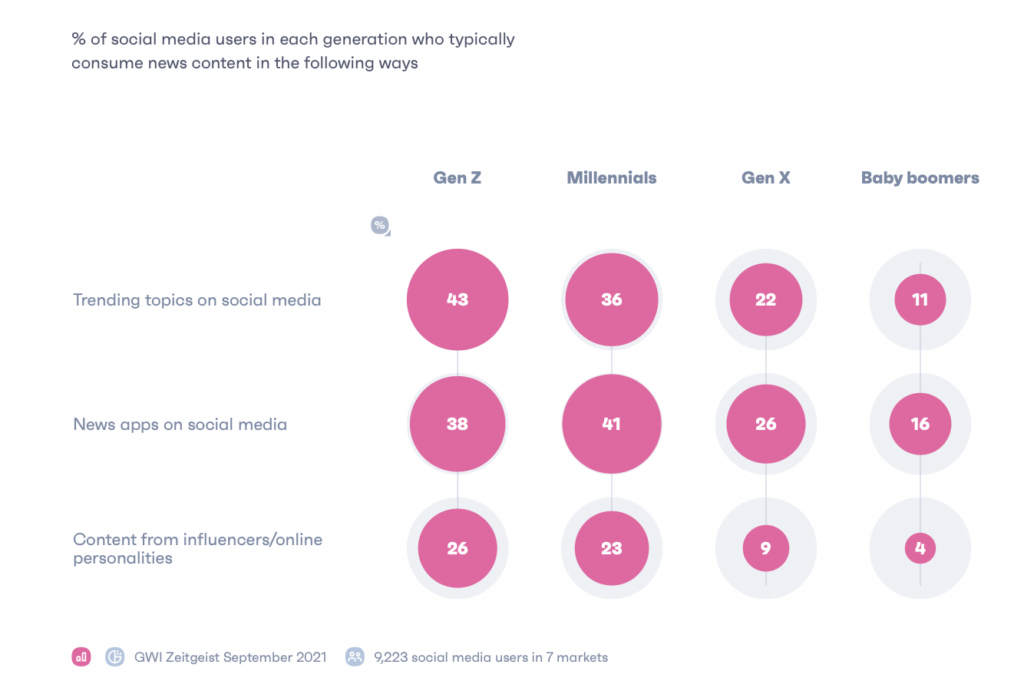
Market of „superapps”
Centralized solutions — these two words best describe social media in the Chinese market. The country’s residents use what are most often referred to as „super apps”, which combine a lot of functions, including purchases — and Chinese users really often use the option of in-app purchases. Western tech companies and apps are trying very hard to be able to serve (or rather retain) their users with similar complexity.
Based on the data, the main user camp of the WeChat super app is made up of the older age group (58+) and the population living in rural areas, not in big cities. WeChat is the most popular, followed by TikTok and Tencent QQ, Baidu Tieba.
In the end, this is more than 10. We hope that you found it useful or interesting – well, maybe even hair-raising. If you are planning to enter a new market, it is always worth looking for similar data and statistics as inspiration, preferably in a regional breakdown, before jumping headfirst into deeper planning.
